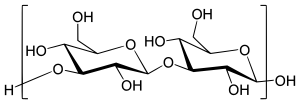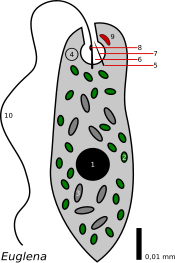Paramylon
| Structural formula | |||||||
|---|---|---|---|---|---|---|---|

|
|||||||
| General | |||||||
| Surname | Paramylon | ||||||
| other names |
|
||||||
| CAS number | 51052-65-4 | ||||||
| Monomer | D - glucose | ||||||
| Molecular formula of the repeating unit | C 6 H 10 O 5 | ||||||
| Molar mass of the repeating unit | 162.14 g mol −1 | ||||||
| Type of polymer |
β- D - (1 → 3) -glucan |
||||||
| properties | |||||||
| Physical state |
firmly |
||||||
| safety instructions | |||||||
|
|||||||
| As far as possible and customary, SI units are used. Unless otherwise noted, the data given apply to standard conditions . | |||||||
Paramylon , Paramylum or Curdlan is a carbohydrate made from glucose that is produced by some bacteria .
properties
Paramylon is a homoglycan of glucose with glycosidic bonds of the type β- (1,3), which is formed by Agrobacterium biobar , Euglena gracilis and Alcaligenes faecalis var. Myxogenes , among others . In some species, paramylons with additional β- (1,6) bonds occur in the periplasm . Curdlan or paramylon is formed by bacteria as part of the glycocalyx or as storage granules .
Paramylon forms hydrogels with water and adopts a helical conformation in water . It's edible and approved as a food additive by the USFDA in the United States , where it's used as an indigestible thickener .
Agrobacteria
In Agrobacteria (sp. ATCC31749 and Agrobacterium tumefaciens ) four genes involved in biosynthesis have been described. A lack of nitrogen compounds leads to an increased biosynthesis of curdlan.
Euglena

In Euglena , paramylon is formed in the pyrenoids and stored in rod-shaped particles in the cytosol . Paramylon is at Euglenophyceae and coralline algae ( Haptophyta occurring) reserve material , which is used as an energy reserve. The name is derived from the Greek para (next to, at) and mylos (mill). Paramylon consists of D - glucose molecules bound together in a chain , so it is a carbohydrate or polysaccharide . While in the starch of green plants and red algae the glucose is linked α-1 → 4- and α-1 → 6-glycosidically, the paramylon of the Euglenophyceae and the calcareous algae consists of β-1 → 3-glycosidically linked glucose.
In the above-mentioned organisms, the storage material is deposited in the cytoplasm in the form of spheres, the so-called paramylon granules .
Use and effect
Scientific studies have shown that Paramylon has a positive influence on blood sugar levels, insulin regulation and cholesterol levels. Another proven effect of paramylon is to stimulate macrophage activity, in this way to stimulate the immune system and thus to have an inhibiting effect on the growth of some types of tumors. Paramylon is also suitable as a renewable raw material for the production of biodegradable plastic films. These foils can be used in cell culture technology, as wound dressings and in the cosmetics sector.
See also
literature
- R. Zhang, KJ Edgar: Properties, chemistry, and applications of the bioactive polysaccharide curdlan. In: Biomacromolecules. Volume 15, Number 4, April 2014, pp. 1079-1096, doi : 10.1021 / bm500038g . PMID 24552241 .
- XB Zhan, CC Lin, HT Zhang: Recent advances in curdlan biosynthesis, biotechnological production, and applications. In: Applied Microbiology and Biotechnology . Volume 93, Number 2, January 2012, pp. 525-531, doi : 10.1007 / s00253-011-3740-2 . PMID 22124723 .
- EJF Spicer, EI Goldenthal, T. Ikeda: A toxicological assessment of curdlan. In: Food and Chemical Toxicology. (1999), Volume 37, pp. 455-479, doi : 10.1016 / S0278-6915 (99) 00013-7 .
Individual evidence
- ↑ Peter M. Collins: Dictionary of Carbohydrates . Chapman & Hall / CRC; 2nd edition 2005; ISBN 0-8493-3829-8 ; P. 523.
- ↑ This substance has either not yet been classified with regard to its hazardousness or a reliable and citable source has not yet been found.
- ↑ M. McIntosh, BA Stone, VA Stanisich: Curdlan and other bacterial (1-> 3) -beta-D-glucans. In: Applied Microbiology and Biotechnology . Volume 68, Number 2, August 2005, pp. 163-173, doi : 10.1007 / s00253-005-1959-5 . PMID 15818477 .
- ↑ BC Lehtovaara FX Gu: Pharmacological, structural, and drug delivery properties and applications of 1,3-β-glucans. In: Journal of agricultural and food chemistry. Volume 59, Number 13, July 2011, pp. 6813-6828, doi : 10.1021 / jf200964u . PMID 21609131 .
- ↑ USFDA Code of Federal Regulations Title 21: Sec. 172,809 curdlan .
- ^ Joint FAO / WHO Expert Committee on Food Additives (JECFA), Monograph for Curdlan , accessed April 15, 2015.
- ↑ T. Karnezis, VC Epa, BA Stone, VA Stanisich: Topological characterization of an inner membrane (1-> 3) -beta-D-glucan (curdlan) synthase from Agrobacterium sp. strain ATCC31749. In: Glycobiology. Volume 13, Number 10, October 2003, pp. 693-706, doi : 10.1093 / glycob / cwg093 . PMID 12851288 .
- ↑ AM Ruffing, RR Chen: Transcriptome profiling of a curdlan-producing Agrobacterium reveals conserved regulatory mechanisms of exopolysaccharide biosynthesis. In: Microbial cell factories. Volume 11, 2012, p. 17, doi : 10.1186 / 1475-2859-11-17 . PMID 22305302 . PMC 3293034 (free full text).
- ↑ R. Calvayrac, D. Laval-Martin, J. Briand, J. Farineau: Paramylon synthesis by Euglena gracilis photoheterotrophically grown under low O2 pressure: Description of a mitochloroplast complex. In: Planta. Volume 153, Number 1, October 1981, pp. 6-13, doi : 10.1007 / BF00385311 . PMID 24276700 .
- ^ AK Monfils, RE Triemer, EF Bellairs: "Characterization of paramylon morphological diversity in photosynthetic euglenoids (Euglenales, Euglenophyta)". Phycologia (2011), Volume 50, Issue 2, p. 156. doi : 10.2216 / 09-112.1 .
- ^ Rüdiger Wehner, Walter Gehring, Alfred Kühn: Zoologie . Thieme, Stuttgart 24th edition 2007; ISBN 3-13-772724-3 ; P. 681.
- ^ A b Cleveland P. Hickman, Larry S. Roberts, Allan Larson, Helen LAnson, David J. Eisenhour, Thomas Lazar (translator): Zoologie . Addison-Wesley Verlag Munich; 13th updated edition 2008; ISBN 978-3-8273-7265-9 ; P. 1287.
- ↑ BARSANTI L, VISMARA R, PASSARELLI V & GUALTIERI P (2001) Paramylon (β-1,3-glucan) content in wild type and WZSL mutant of Euglena gracilis. Effects of growth conditions. J Appl Phycol 13: 59-65.
- ↑ QUESEDA LA DE LUSTIG ES, MARECHAL LR & BELOCOPITOW E (1976) Antitumor activity of paramylon on sarcoma-180 in mice. Gann 67: 455-459.
- ↑ BÄUMER D (1998) Isolation and partial characterization of the paramylon synthase from Euglena gracilis (Euglenozoa). Dissertation University of Bielefeld.